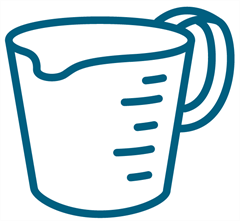SOY + MEN'S HEALTH
Soyfoods may offer significant health benefits to men, such as lowering the risk of prostate cancer, heart disease and more. As this fact sheet will discuss, men need not fear the risk of feminization.
Introduction
Much of the research on the health effects of soyfoods has focused on postmenopausal women. In large part, this focus is because among commonly consumed foods the soybean is a uniquely-rich source of isoflavones, a group of naturally-occurring plant chemicals that are classified as phytoestrogens although they differ at both the molecular and clinical level from the hormone estrogen. The presence of isoflavones in soyfoods has led to concerns that consuming soy feminizes men. However, extensive clinical data show this concern to be unwarranted as neither soyfoods nor isoflavones affect circulating testosterone1 and estrogen2 levels nor adversely affecting sperm or semen parameters.3,4
Furthermore, there are several reasons for encouraging men to make soyfoods a part of their diet. For example, soy protein supplementation leads to gains in strength and lean tissue in men engaged in resistance exercise training.
These gains in strength are similar to supplementing with whey protein.5 There is also intriguing but very speculative evidence, that soy reduces risk of developing prostate cancer.6 In addition, clinical studies show that soy protein modestly lowers low-density-lipoprotein cholesterol levels.7-9
Cholesterol levels will also be lowered when soyfoods replace common sources of protein because of the favorable change in the fatty acid content of the diet.9 Many soyfoods are rich sources of polyunsaturated fat. Overall, the data shows soyfoods can positively contribute to the health of men. Research has shown that soy is safe for men to consume and that they may benefit from including soyfoods in their diet.
Isoflavones

Each serving (e.g., 1 cup soymilk or ½ cup tofu or edamame) of a minimally processed soyfood provides about 25 mg of isoflavones or 3.5 mg isoflavones per gram of protein.
Generally, more refined soy products such as isolated soy protein have much lower isoflavone concentrations (mg/g protein) than traditional Asian soyfoods.
Isoflavones are diphenolic nonsteroidal molecules that have a chemical structure similar to the hormone estrogen. Consequently, they are able to bind to both estrogen receptors (ER) and to exert estrogen-like effects under certain experimental conditions. For this reason, isoflavones are commonly referred to as phytoestrogens.
However, isoflavones are also classified as selective estrogen receptor modulators (SERMs).12 SERMs can function as ER agonists, ER antagonists or have no effects at all in tissue that possess ERs. The preference of isoflavones to bind to and activate ERβ in comparison to ERβ is thought to account for the SERM-like properties of these soybean constituents.12 The two ERs when activated, can have very different and sometimes even opposite physiological effects.
It is not surprising that isoflavones and estrogen differ at the molecular and clinical level, since small differences in chemical structure can result in huge differences in physiological effects. For example, although phytosterols and cholesterol are almost identical in structure (much more so than estrogen and isoflavones), phytosterols lower circulating cholesterol levels13 whereas cholesterol very modestly raises blood cholesterol.14 Thus, isoflavones should not be equated with estrogen, and for that matter, isoflavones should not be equated with soyfoods because like all foods, soyfoods contain hundreds of biologically active components.

Soy Protein Quality and Lean Tissue Accretion
The importance of maintaining muscle mass throughout life for optimal health is becoming increasingly apparent.15 While it is true that most American men meet or exceed the recommended dietary allowance (RDA) for protein, this may not be the case for as much as 40 percent of older men.16 Furthermore, some recent data suggest that the RDA may be too low and that protein intake exceeding the RDA may be advantageous.17-19 For men >65 years of age, estimates are that the current RDA is underestimated by about 30 percent.20 Soyfoods are good choices for meeting dietary protein needs because they provide high-quality protein.21

The digestibility of soy protein from different sources ranges from about 90 to 100 percent.22-27 Soy protein also has an excellent amino acid profile. In contrast to other legume proteins, the content of the sulfur amino acids (methionine and cystine), the limiting amino acids in legume proteins, is sufficient to meet biological requirements.21 Not surprisingly, the protein digestibility corrected amino acid scores for soy protein from different sources range from about 0.9 to 1.0, the latter being the highest possible score. These values are similar to the values for animal proteins and much higher than the scores for nearly all other plant proteins.21 The high quality of soy protein is also evident when evaluating protein quality using the digestible indispensable amino acid score.28,29
Despite the high quality of soy protein, claims have been made that soy protein is not a good choice for men wanting to increase muscle mass.30 However, according to a recently published meta-analysis, soy protein supplementation leads to gains in strength and lean tissue in individuals engaged in resistance exercise training to a similar extent as whey protein supplementation, despite soy protein being lower in leucine than whey.5 Leucine is the amino acid primarily responsible for triggering muscle protein synthesis.31
Whey protein is generally considered to be the optimal protein for building muscle, and in acute studies (<5 hours), it stimulates muscle protein synthesis to a much greater extent than soy protein.30 However, it appears that these short-term studies are poor predictors of the effects observed in longer-term studies (>6 weeks duration) that examined strength and lean tissue accretion. In fact, recent data suggest that protein amount is much more important than protein type with respect to lean body mass accretion.32 Having said that, soy protein may actually have some advantages over other high-quality proteins by reducing exercise-induced inflammation and oxidation.33-35 There is also evidence that the combination of soy protein and whey protein may have advantages over either protein alone.36,37
| SOYFOOD | SERVING SIZE | GRAMS OF SOY PROTEIN |
|---|---|---|
| Fortified Soymilk | 1 cup | 6-7 |
| Soy Cereal | 1 ¼ cup | 7 |
| Soy Yogurt, Vanilla | 1 cup | 6 |
| Soy Breakfast Patty | 2 patties | 11 |
| Soy Bar | 1 bar | 14 |
| Soy Chips | 1 bag | 7 |
| Soynut Butter | 2 tbsp | 7 |
| Soynuts, Roasted, Unsalted | ¼ cup | 11 |
| Tofu | ½ cup | 10 |
| Edamame | ½ cup | 11 |
| Soy Burger | 1 patty | 13-14 |
| Soy Pasta | ½ cup (cooked) | 13 |
| Soy Pudding | ½ cup | 6 |
Source: United States Department of Agriculture Nutrient Database.
Protein intake greatly exceeding the protein RDA is not likely to adversely affect renal function in healthy individuals38 but protein amount and type in individuals at risk of developing renal disease may be an important consideration.39 In this regard it is notable that a meta-analysis of clinical studies by Jing et al.40 found that isoflavone-rich soy protein significantly decreased serum creatinine, serum phosphorus, C-reactive protein and proteinura in predialysis patients. Serum phosphorus levels often become abnormally high in individuals whose renal function is compromised, so replacing animal protein with soy protein could be helpful. The aforementioned analysis also found that soy protein helped maintain the nutritional status of dialysis patients.40 A previously published meta-analysis41 found similar results as the one by Jing et al.40
Prostate Cancer
Prostate cancer is the second most commonly diagnosed cancer in men worldwide. According to the International Agency for Research on Cancer’s GLOBOCAN database, 1.1 million men were diagnosed with prostate cancer in 2012, accounting for 15 percent of all cancers in men.42
Interest in the role that soy may play in reducing risk of developing prostate cancer dates back three decades.43 In large part, the initial focus on prostate cancer can be attributed to the historically lower prostate cancer mortality rates in Asian soyfood-consuming countries.44

The low rates of prostate cancer among Asian countries compared to Western countries and in particular Japan, a country with a high socioeconomic status, have led to attempts to identify factors responsible for this difference. Similarly the relatively recent rise in prostate cancer rates has occurred in many Asian countries. To this point, the age-adjusted Japanese prostate cancer mortality rate per 100,000 men was as low as 0.5 in 1950, 3.2 in 1970 and 8.6 in 1998.45 While there may be many factors contributing to this increase, westernization of the diet is thought to be an important one. Conversely, the consumption of soyfoods has been proposed to contribute to the historically low rates.
Recently, Applegate et al.6 conducted a meta-analysis of 30 epidemiologic studies that evaluated the relationship between soy and soybean isoflavones and prostate cancer risk. The data show that soy consumption is protective against prostate cancer. More specifically, intake of total soyfoods (p < 0.001), genistein (p=0.008), daidzein (p=0.018), and unfermented soyfoods (p < 0.001) was each significantly associated with a reduced risk of cancer. In contrast, neither soyfood intake nor circulating isoflavones were associated with advanced prostate cancer, although very few studies evaluated this association. Overall, total soyfood intake was associated with a 29% reduction in risk (relative risk [RR], 0.71; 95% confidence interval: 0.58, 0.85, p < 0.001).

However, it is important to point out that when sub-analyzing the data according to the type of epidemiologic study, protective effects were noted in case-control (n=9; RR = 0.61) but not in cohort studies (n=7; RR = 0.90). Cohort studies carry more weight within the epidemiologic community. For this reason, the recent analysis by Perez-Cornago et al.46 is particularly interesting. These authors evaluated the relationship between serum isoflavone levels from individuals participating in one of seven prospective studies, two from Japan (241 cases and 503 controls) and five from Europe (2,828 cases and 5,593 controls). No relationship between isoflavone levels and risk was noted in European men. In contrast, in men from Japan, when comparing fourth quartile with first quartile genistein levels, the odds ratio (95% confidence interval) was 0.70 (0.45, 1.10). Although this finding was not quite statistically significant, it is suggestive of a protective effect. The lack of effect in European men is not surprising given their negligible soy intake. Western epidemiologic studies involving the general population are unable to provide meaningful insight into the health effects of soyfoods because intake is too low to expect physiological effects to result.47
In addition to the epidemiologic research, several investigators have evaluated the effects of isoflavone exposure on prostate specific antigen (PSA) levels. PSA is the most common clinical test for the detection of prostate cancer, although its use in routine screening has recently been challenged.48-51 While several studies showed that isoflavones favorably affect PSA levels, overall this research has produced very mixed results.52-58
Finally, neither of the two large long-term trials that evaluated the effects of isoflavone exposure on the progression of prostate cancer reported benefits. However, in one of these studies, men in the soy group received only approximately 24 mg genistein daily.59 This is a relatively low genistein dose for men who had already undergone radical prostatectomy for the treatment of prostate cancer. In the other study, in addition to the treated group consuming isoflavone-rich soy protein, they were administered supplements of vitamin E and selenium.60 There is some evidence that both of these micronutrients stimulate the development of prostate cancer under certain conditions.61 The results of these long-term trials involving soy are not surprising when the limitations of the experimental designs are considered.
Hormone Levels and Fertility
Two case reports,62,63 each describing an individual man, plus a case-control study64 that evaluated the relationship between diet and sperm count and concentration, appear to underlie concerns that soy feminizes men. One case report described a 60-year-old man who developed gynecomastia likely as a result of a dramatic rise in circulating estrogen levels.62 These levels were ten-fold higher than the levels following discontinuation of soy consumption. In the other case report, a 19-year old male vegan developed low testosterone levels, loss of libido and erectile dysfunction.63
If soy consumption was in fact responsible for the observed feminizing effects, it is because such excessive amounts were consumed in the context of an unbalanced and likely nutrient-deficient diet. Coincidentally, both men reportedly ingested 360 mg/d isoflavones, an intake about 9-fold higher than is typical for Japanese men consuming a traditional diet.
Most importantly, clinical studies show that neither soy nor isoflavone intake, even when intake exceeds typical Japanese intake, affects circulating estrogen or testosterone levels. In support of these conclusions is a meta-analysis that included 32 studies (including the two noted above) and 36 treatment groups that found there were no significant effects of soy protein or isoflavone intake on levels of total testosterone, sex hormone binding globulin, free testosterone or the free androgen index.1 Studies published subsequent to this analysis are supportive of this conclusion.37,65-68 Also, a narrative review that included nine clinical studies found no effect of soy on estrogen levels.2
Research published subsequent to this review is supportive of this conclusion.37,69 The results of a small pilot case-control study raised concern that soy could adversely impact male fertility. Chavarro et al.70 found that men who were classified as soy-consumers had lower sperm concentrations than non-consumers of soy. However, there were several limitations to this research. For example, about half of the decreased sperm concentration resulted from an increase in ejaculate volume, which accounts for sperm concentration decreasing but not sperm count. It is biologically implausible that soy consumption would increase ejaculate volume.

Furthermore, clinical studies, two of which were published in full manuscript form, found that isoflavone exposure does not impact sperm or semen parameters. In one of these, healthy volunteers took a daily supplement containing 40 mg isoflavones for two months.3 In another, 32 healthy young men consumed diets in random order for 57 days that were supplemented with milk protein isolate or isolated soy protein containing a high or low amount of isoflavones.4 In the third study, 20 volunteers were randomized to three different groups in which they were provided 60, 320 or 480 mg/d isoflavones for three months.71 A notable finding is that sperm concentration was unaffected in response to such large amounts of isoflavones. Interestingly, a case report described a benefit from isoflavone supplementation in a male with low sperm concentration who was unable to father a child. Daily isoflavone supplementation for six months led to normalization of sperm quality and quantity and to the birth of a healthy infant.72 As a result, the authors of this report suggested that isoflavones may be a treatment for low sperm concentration.
Finally, in a cross-sectional study involving 184 men from couples undergoing infertility treatment with in vitro fertilization, male partner’s intake of soyfoods and soy isoflavones was unrelated to; fertilization rates, proportions of poor quality embryos, accelerated or slow embryo cleavage rate, implantation, clinical pregnancy and live birth among couples attending an infertility clinic.73 This study was conducted by the authors of the previously cited case-control study that raised concerns about the impact of soy on sperm concentration.70
Summary and Conclusions
Soyfoods can play an important role in the diets of men. They provide high-quality protein and healthy fat. Soy protein modestly lowers blood cholesterol levels and is a good choice for those wanting to increase muscle mass. There is speculative evidence that soyfoods reduce risk of developing prostate cancer. Finally, there is no meaningful clinical evidence that soy feminizes men as it does not affect circulating levels of estrogen or testosterone or affect sperm or semen.
References
1. Hamilton-Reeves JM, Vazquez G, Duval SJ, et al. Clinical studies show no effects of soy protein or isoflavones on reproductive hormones in men: results of a meta-analysis. Fertil Steril. 2010;94(3):997-1007.
2. Messina M. Soybean isoflavone exposure does not have feminizing effects on men: a critical examination of the clinical evidence. Fertil Steril. 2010;93(7):2095-104.
3. Mitchell JH, Cawood E, Kinniburgh D, et al. Effect of a phytoestrogen food supplement on reproductive health in normal males. Clin Sci (Lond). 2001;100(6):613-8.
4. Beaton LK, McVeigh BL, Dillingham BL, et al. Soy protein isolates of varying isoflavone content do not adversely affect semen quality in healthy young men. Fertil Steril. 2010;94(5):1717-22.
5. Messina M, Lynch H, Dickinson JM, et al. No difference between the effects of supplementing with soy protein versus animal protein on gains in muscle mass and strength in response to resistance exercise. International journal of sport nutrition and exercise metabolism. 20181-36.
6. Applegate CC, Rowles JL, Ranard KM, et al. Soy consumption and the risk of prostate cancer: An updated systematic review and meta-analysis. Nutrients. 2018;10(1).
7. Anderson JW, Bush HM. Soy protein effects on serum lipoproteins: A quality assessment and meta-analysis of randomized, controlled studies. J Am Coll Nutr. 2011;30(2):79-91.
8. Zhan S, Ho SC. Meta-analysis of the effects of soy protein containing isoflavones on the lipid profile. Am J Clin Nutr. 2005;81(2):397-408.
9. Jenkins DJ, Mirrahimi A, Srichaikul K, et al. Soy protein reduces serum cholesterol by both intrinsic and food displacement mechanisms. J Nutr. 2010;140(12):2302S-11S.
10. Murphy PA, Barua K, Hauck CC. Solvent extraction selection in the determination of isoflavones in soy foods. Journal of chromatography B, Analytical technologies in the biomedical and life sciences. 2002;777(1-2):129-38.
11. Messina M, Nagata C, Wu AH. Estimated Asian adult soy protein and isoflavone intakes. Nutr Cancer. 2006;55(1):1-12.
12. Oseni T, Patel R, Pyle J, et al. Selective estrogen receptor modulators and phytoestrogens. Planta Med. 2008;74(13):1656-65.
13. AbuMweis SS, Marinangeli CP, Frohlich J, et al. Implementing phytosterols into medical practice as a cholesterol-lowering strategy: overview of efficacy, effectiveness, and safety. Can J Cardiol. 2014;30(10):1225-32.
14. Kanter MM, Kris-Etherton PM, Fernandez ML, et al. Exploring the factors that affect blood cholesterol and heart disease risk: is dietary cholesterol as bad for you as history leads us to believe? Adv Nutr. 2012;3(5):711-7.
15. Wolfe RR, Cifelli AM, Kostas G, et al. Optimizing protein intake in adults: Interpretation and application of the recommended dietary allowance compared with the acceptable macronutrient distribution range. Adv Nutr. 2017;8(2):266-75.
16. Kerstetter JE, O’Brien KO, Insogna KL. Low protein intake: the impact on calcium and bone homeostasis in humans. J Nutr. 2003;133(3):855S-61S.
17. Humayun MA, Elango R, Ball RO, et al. Reevaluation of the protein requirement in young men with the indicator amino acid oxidation technique. Am J Clin Nutr. 2007;86(4):995-1002.
18. Elango R, Humayun MA, Ball RO, et al. Evidence that protein requirements have been significantly underestimated. Current opinion in clinical nutrition and metabolic care. 2010;13(1):52-7.
19. Paddon-Jones D, Rasmussen BB. Dietary protein recommendations and the prevention of sarcopenia. Current opinion in clinical nutrition and metabolic care. 2009;12(1):86-90.
20. Rafii M, Chapman K, Elango R, et al. Dietary protein requirement of men >65 years old determined by the indicator amino acid oxidation technique is higher than the current estimated average requirement. J Nutr. 2016;146681-7.
21. Hughes GJ, Ryan DJ, Mukherjea R, et al. Protein digestibility-corrected amino acid scores (PDCAAS) for soy protein isolates and concentrate: Criteria for evaluation. J Agric Food Chem. 2011;59(23):12707-12.
22. Takahashi T, Muramatsu S, Muramatsu Y. [Comparison of nutritive values between soy protein isolate and tofu]. Nutritional science soy protein. 1983;493-8.
23. Cheng LT, Li HC, Lan TH. Biological values of soybean protein and mixed soybean-pork and soybean-egg proteins in human subjects. Chinese J Physiol. 1941;16(1):83-90.
24. Cahill WM, Schroeder LJ, Smith AH. Digestibility and biological value of soybean protein in whole soybeans, soybean flour, and soybean milk. J Nutr. 1944;28209-18.
25. Adolph WH, Wan Y-L. The digestibility of the protein of soybean milk. Chinese J Physiol. 1934;8171-8.
26. Babji AS, Fatimah S, Ghassem M, et al. Protein quality of selected edible animal and plant protein sources using rat bio-assay. Int Food Res J. 2010;17303-8.
27. Pian J, H-C. Biological value of the proteins of mung bean, peanut and bean curd. Chinese J Physiol. 1930;4431-6.
28. Rutherfurd SM, Fanning AC, Miller BJ, et al. Protein digestibility-corrected amino acid scores and digestible indispensable amino acid scores differentially describe protein quality in growing male rats. J Nutr. 2015;145(2):372-9.
29. Mathai JK, Liu Y, Stein HH. Values for digestible indispensable amino acid scores (DIAAS) for some dairy and plant proteins may better describe protein quality than values calculated using the concept for protein digestibility-corrected amino acid scores (PDCAAS). Br J Nutr. 2017;117(4):490-9.
30. Devries MC, Phillips SM. Supplemental protein in support of muscle mass and health: advantage whey. J Food Sci. 2015;80 Suppl 1A8-A15.
31. Kimball SR. Leucine-induced upregulation of terminal oligopyrimidine mRNA translation in skeletal muscle: Just the tip of the iceberg? J Nutr. 2017;147(9):1603-4.
32. Morton RW, Murphy KT, McKellar SR, et al. A systematic review, meta-analysis and meta-regression of the effect of protein supplementation on resistance training-induced gains in muscle mass and strength in healthy adults. Br J Sports Med. 2017;52376-84.
33. DiSilvestro RA, Mattern C, Wood N, et al. Soy protein intake by active young adult men raises plasma antioxidant capacity without altering plasma testosterone. Nutr Res. 2006;2692-5.
34. Brown EC, Disilvestro RA, Babaknia A, et al. Soy versus whey protein bars: Effects on exercise training impact on lean body mass and antioxidant status. Nutrition journal. 2004;3(1):22.
35. Hill S, Box W, DiSilvestro RA. Moderate intensity resistance exercise, plus or minus soy intake: effects on serum lipid peroxides in young adult males. International journal of sport nutrition and exercise metabolism. 2004;14(2):125-32.
36. Reidy PT, Borack MS, Markofski MM, et al. Protein supplementation has minimal effects on muscle adaptations during resistance exercise training in young men: A double-blind randomized clinical trial. J Nutr. 2016;146(9):1660-9.
37. Haun CT, Mobley CB, Vann CG, et al. Soy protein supplementation is not androgenic or estrogenic in college-aged men when combined with resistance exercise training. Scientific reports. 2018;8(1):11151.
38. Van Elswyk ME, Weatherford CA, McNeill SH. A Systematic Review of Renal Health in Healthy Individuals Associated with Protein Intake above the US Recommended Daily Allowance in Randomized Controlled Trials and Observational Studies. Adv Nutr. 2018;9(4):404-18.
39. Phillips SM, Chevalier S, Leidy HJ. Protein “requirements” beyond the RDA: implications for optimizing health. Applied physiology, nutrition, and metabolism = Physiologie appliquee, nutrition et metabolisme. 2016;41(5):565-72.
40. Jing Z, Wei-Jie Y. Effects of soy protein containing isoflavones in patients with chronic kidney disease: A systematic review and meta-analysis. Clin Nutr. 2015.
41. Zhang J, Liu J, Su J, et al. The effects of soy protein on chronic kidney disease: a meta-analysis of randomized controlled trials. Eur J Clin Nutr. 2014;68(9):987-93.
42. GLOBOCAN. Cancer Fact Sheets: Prostate Cancer. Available online: http://globocan.iarc.fr/old/. FactSheets/cancers/prostate-new.asp (accessed on July 14, 2018).
43. Severson RK, Nomura AM, Grove JS, et al. A prospective study of demographics, diet, and prostate cancer among men of Japanese ancestry in Hawaii. Cancer Res. 1989;49(7):1857-60.
44. Pisani P, Parkin DM, Bray F, et al. Estimates of the worldwide mortality from 25 cancers in 1990. Int J Cancer. 1999;83(1):18-29.
45. Suzuki K. Epidemiology of prostate cancer and benign prostatic hyperplasia. J Japan Medical Assoc. 2009;52(478-83).
46. Perez-Cornago A, Appleby PN, Boeing H, et al. Circulating isoflavone and lignan concentrations and prostate cancer risk: A meta-analysis of individual participant data from seven prospective studies including 2828 cases and 5593 controls. Int J Cancer. 2018.
47. Messina M. Western soy intake is too low to produce health effects. Am J Clin Nutr. 2004;80(2):528-9.
48. McNaughton-Collins MF, Barry MJ. One man at a time--resolving the PSA controversy. N Engl J Med. 2011;365(21):1951-3.
49. Hernandez BY, McDuffie K, Franke AA, et al. Reports: plasma and dietary phytoestrogens and risk of premalignant lesions of the cervix. Nutr Cancer. 2004;49(2):109-24.
50. Joint effects of systolic blood pressure and serum cholesterol on cardiovascular disease in the Asia Pacific region. Circulation. 2005;112(22):3384-90.
51. Bibbins-Domingo K, Grossman DC, Curry SJ. The US Preventive Services Task Force 2017 Draft Recommendation Statement on Screening for Prostate Cancer: An Invitation to Review and Comment. JAMA. 2017;317(19):1949-50.
52. Messina M, Kucuk O, Lampe JW. An overview of the health effects of isoflavones with an emphasis on prostate cancer risk and prostate-specific antigen levels. J AOAC Int. 2006;89(4):1121-34.
53. Pendleton JM, Tan WW, Anai S, et al. Phase II Trial of Isoflavone in prostate specific antigen recurrent prostate cancer after previous local therapy. BMC Cancer. 2008;8(1):132.
54. Kwan W, Duncan G, Van Patten C, et al. A phase II trial of a soy beverage for subjects without clinical disease with rising prostate-specific antigen after radical radiation for prostate cancer. Nutr Cancer. 2010;62(2):198-207.
55. Ide H, Tokiwa S, Sakamaki K, et al. Combined inhibitory effects of soy isoflavones and curcumin on the production of prostate-specific antigen. Prostate. 2010;70(10):1127-33.
56. Lazarevic B, Boezelijn G, Diep LM, et al. Efficacy and safety of short-term genistein intervention in patients with localized prostate cancer prior to radical prostatectomy: a randomized, placebo-controlled, double-blind Phase 2 clinical trial. Nutr Cancer. 2011;63(6):889-98.
57. Joshi M, Agostino NM, Gingrich R, et al. Effects of commercially available soy products on PSA in androgen-deprivation-naive and castration-resistant prostate cancer. South Med J. 2011;104(11):736-40.
58. Paur I, Lilleby W, Bohn SK, et al. Tomato-based randomized controlled trial in prostate cancer patients: Effect on PSA. Clin Nutr. 2017;36(3):672-9.
59. Bosland MC, Kato I, Zeleniuch-Jacquotte A, et al. Effect of soy protein isolate supplementation on biochemical recurrence of prostate cancer after radical prostatectomy: a randomized trial. JAMA. 2013;310(2):170-8.
60. Fleshner NE, Kapusta L, Donnelly B, et al. Progression from high-grade prostatic intraepithelial neoplasia to cancer: a randomized trial of combination vitamin-E, soy, and selenium. J Clin Oncol. 2011;29(17):2386-90.
61. Kristal AR, Darke AK, Morris JS, et al. Baseline selenium status and effects of selenium and vitamin e supplementation on prostate cancer risk. J Natl Cancer Inst. 2014;106(3):djt456.
62. Martinez J, Lewi JE. An unusual case of gynecomastia associated with soy product consumption. Endocr Pract. 2008;14(4):415-8.
63. Siepmann T, Roofeh J, Kiefer FW, et al. Hypogonadism and erectile dysfunction associated with soy product consumption. Nutrition. 2011;27(7-8):859-62.
64. Chavarro JE, Toth TL, Sadio SM, et al. Soy food and isoflavone intake in relation to semen quality parameters among men from an infertility clinic. Hum Reprod. 2008;23(11):2584-90.
65. Deibert P, Solleder F, Konig D, et al. Soy protein based supplementation supports metabolic effects of resistance training in previously untrained middle aged males. Aging Male. 2011;14(4):273-9.
66. Miyanaga N, Akaza H, Hinotsu S, et al. Prostate cancer chemoprevention study: an investigative randomized control study using purified isoflavones in men with rising prostate-specific antigen. Cancer Sci. 2012;103(1):125-30.
67. Sathyapalan T, Rigby AS, Bhasin S, et al. Effect of soy in men with type 2 diabetes mellitus and subclinical hypogonadism: A randomized controlled study. J Clin Endocrinol Metab. 2017;102(2):425-33.
68. Hamilton-Reeves JM, Banerjee S, Banerjee SK, et al. Short-term soy isoflavone intervention in patients with localized prostate cancer: a randomized, double-blind, placebo-controlled trial. PloS one. 2013;8(7):e68331.
69. Kumar NB, Kang L, Pow-Sang J, et al. Results of a randomized phase I dose-finding trial of several doses of isoflavones in men with localized prostate cancer: administration prior to radical prostatectomy. J Soc Integr Oncol. 2010;8(1):3-13.
70. Chavarro JE, Rich-Edwards JW, Rosner B, et al. A prospective study of dairy foods intake and anovulatory infertility. Hum Reprod. 2007;22(5):1340-7.
71. Messina M, Watanabe S, Setchell KD. Report on the 8th International Symposium on the Role of Soy in Health Promotion and Chronic Disease Prevention and Treatment. J Nutr. 2009;139(4):796S-802S.
72. Casini ML, Gerli S, Unfer V. An infertile couple suffering from oligospermia by partial sperm maturation arrest: can phytoestrogens play a therapeutic role? A case report study. Gynecol Endocrinol. 2006;22(7):399-401.
73. Minguez-Alarcon L, Afeiche MC, Chiu YH, et al. Male soy food intake was not associated with in vitro fertilization outcomes among couples attending a fertility center. Andrology. 2015;3(4):702-8.
Connect with us through our social channels